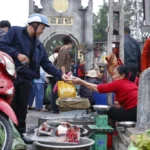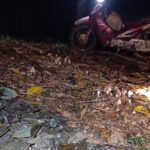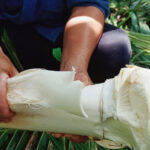For a period of time, the art of paper flower-making was lost for about 50 years. Fortunately, some villagers, artisans Nguyen Hoa and painter Than Van Huy, worked tirelessly to rediscover and revive the lost art.
While fresh flowers wither quickly and are difficult to preserve, paper flowers can retain their beauty for a long time and carry profound spiritual meanings. Through the ups and downs of history, the paper flower-making tradition of Thanh Tien village has endured and flourished, becoming a distinctive cultural feature of Hue.
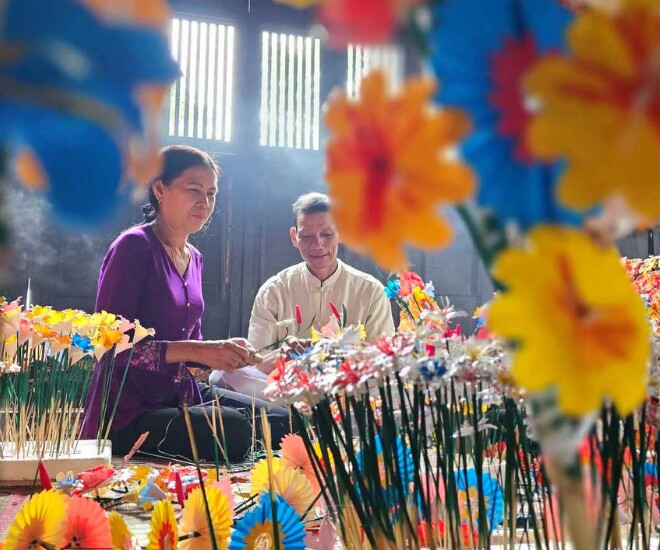
Thanh Tien paper flowers stand out for their vibrant colors and elegant forms. They are long-lasting, economical, and convey a sense of solemnity and reverence.
The paper flowers of Thanh Tien are entirely handmade, from selecting materials, cutting, shaping, to painting. The main ingredients are colored paper, bamboo, rattan, and adhesive. Creating a perfect flower involves numerous meticulous steps, requiring dexterity and patience from the artisans.
To make a flower stem, the artisans have to prepare the bamboo several months before the rainy season in Hue. They choose the best bamboo in the village, split and shave it into thin strips, and then sun-dry them to use as flower stems. In addition to flowers like orchids, lilies, roses, chrysanthemums, wild chrysanthemums, and wallflowers, which are made only for worship and rituals during the Tet holiday, the village also crafts lotus flowers from paper. Each Thanh Tien paper flower is a unique work of art, showcasing the talent and dedication of its artisan.
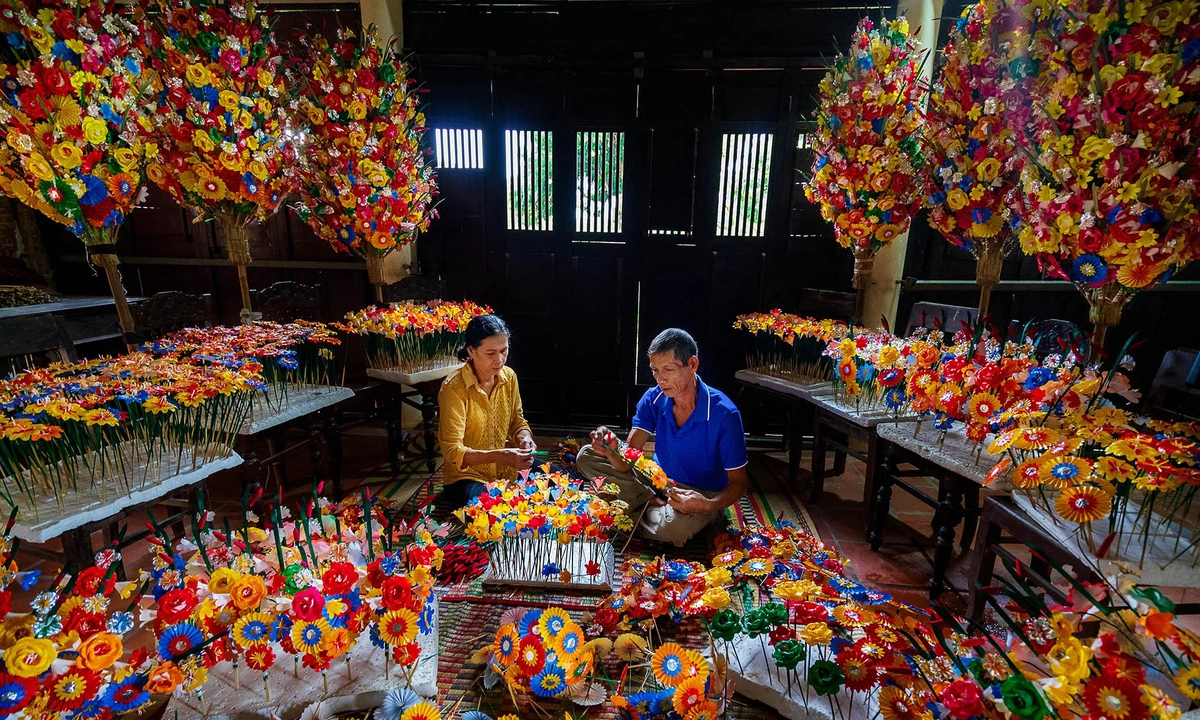
Located along the lower Perfume River, about 8 kilometers from Truong Tien Bridge, Thanh Tien village in Phu Mau commune, Hue city, is renowned for its 300-year-old paper flower-making tradition. In 2013, the Hue People’s Committee recognized Thanh Tien as a traditional craft village.
Thanh Tien paper flowers come in various types, including lotuses, chrysanthemums, roses, and spiritually symbolic flowers like lotus flowers for Buddha worship and chrysanthemums for ancestor worship. Each flower carries a unique meaning, reflecting the villagers’ wishes for peace, happiness, and prosperity.
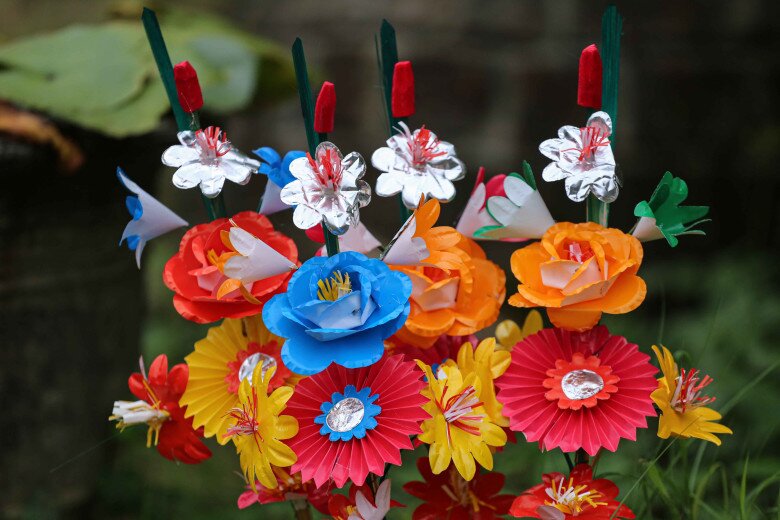
Beyond being a handicraft, Thanh Tien paper flowers embody profound cultural and spiritual values.
These paper flowers are commonly used to decorate ancestral altars, Buddhist altars, temples, and pagodas during festivals and holidays. Especially during the Tet holiday, the village buzzes with activity as people flock to buy paper flowers to adorn their homes, wishing for a prosperous new year.
Today, Thanh Tien paper flower village is not only a traditional craft hub but also an appealing tourist destination. Visitors can admire the vibrant paper flowers and learn about the history, culture, and local lifestyle. Preserving and promoting the value of Thanh Tien paper flowers not only helps maintain the nation’s cultural identity but also boosts tourism and creates job opportunities for the locals.
To reach Thanh Tien paper flower village, travel about 5 kilometers from the city center past Dong Ba market, along Huynh Thuc Khang Street, to reach the ancient town of Bao Vinh. Cross the river by boat to Tien Non village, and from there, it’s just a 1-kilometer walk to the village.
Currently, Thanh Tien paper flowers have evolved into two distinct product lines: traditional flowers for worship and spiritual practices, and intricate, artistic flowers for display and tourism services.
Cuisine in Hue
When visiting the traditional paper flower-making village of Thanh Tien, don’t miss out on trying these delicious specialties:
Hen Rice
Hen rice has become a must-try delicacy for tourists visiting the ancient capital. This dish is a delightful blend of flavors, with a spicy kick from chili peppers.
White rice is mixed with stir-fried hen meat, crispy pork skin, roasted peanuts, fresh herbs, and fermented shrimp paste. The unique taste comes from the combination of sweet hen meat, crunchy pork skin, nutty peanuts, and savory shrimp paste. Hen rice is typically served with a hot bowl of hen broth.
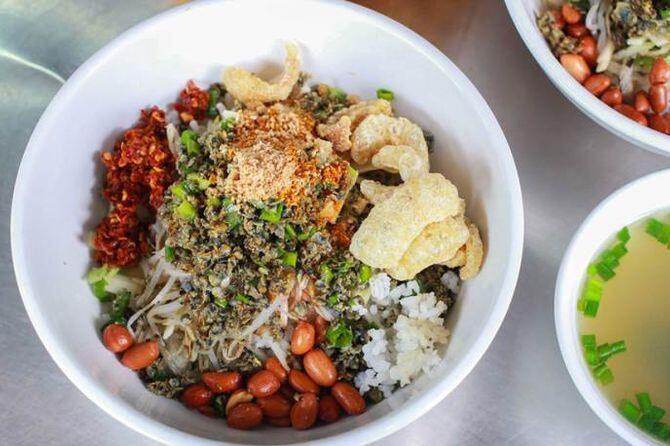
Hue’s hen rice is a harmonious blend of flavors, featuring sour green mango, nutty red peanuts, refreshing water spinach, and fragrant herbs.
Hue Beef Noodle Soup
Hue beef noodle soup is a famous dish in Hue cuisine. The thick rice noodles are served with beef, pork legs, crab cakes, and a flavorful broth. The broth is simmered from beef and pork bones, along with distinctive Hue spices. This dish is usually accompanied by fresh herbs, lime, and chili peppers.
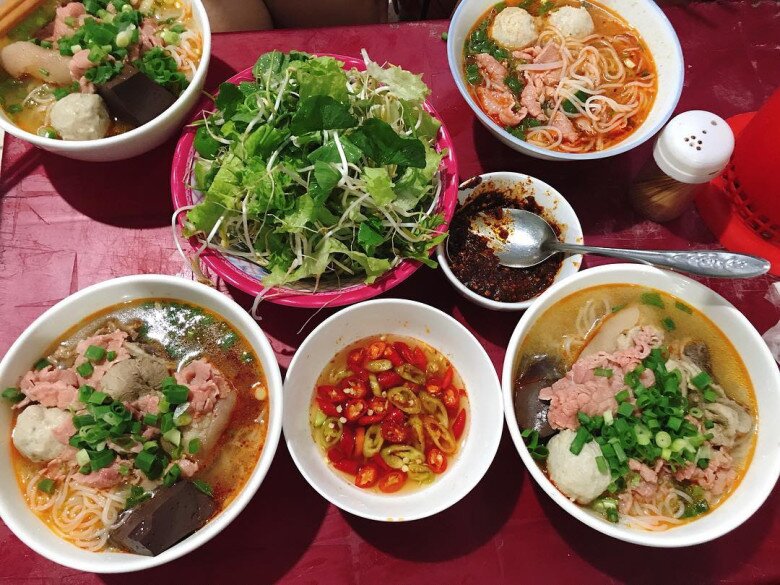
The broth, simmered from beef bones, combines with chewy beef slices to create an irresistible flavor.
Banh Khoai
Banh Khoai is a fried pancake, similar in shape to a sizzling cake. It is typically served with fresh herbs and a dipping sauce.
The name “Banh Khoai” originates from the way Hue locals refer to the smoke that rises when cooking the cake over a charcoal stove. In the past, people in Hue often made cakes from rice flour and used charcoal stoves for cooking. Whenever the stove went out, smoke would rise, and they decided to name the cake after this phenomenon. However, due to the local accent, the vowel “oi” shifted to “oai,” resulting in the name “Banh Khoai.”
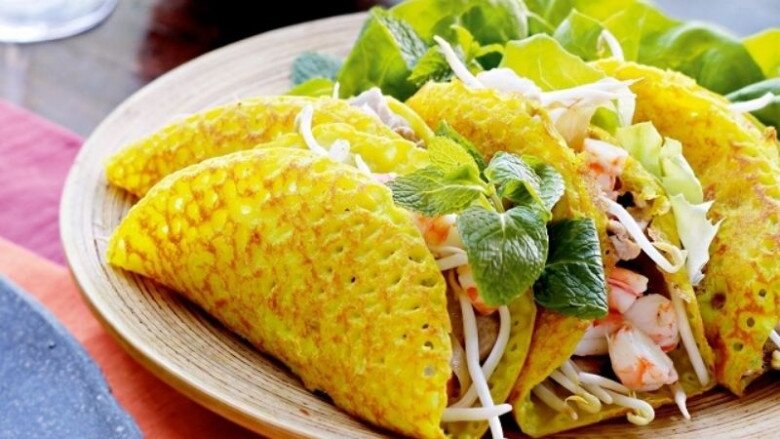
Banh Khoai captivates the taste buds with the crispiness of the cake, the sweetness of shrimp and meat, and the sweet and sour dipping sauce.
Banh Beo
Banh Beo Hue, a humble yet exquisite delicacy of the ancient capital, captivates diners with its delicate flavor and graceful appearance. Each tiny cake, nestled in a small bowl, resembles a shy water-hyacinth flower, adorned with the green of fried shallots, the golden hue of shrimp flakes, and the vibrant colors of fresh herbs.
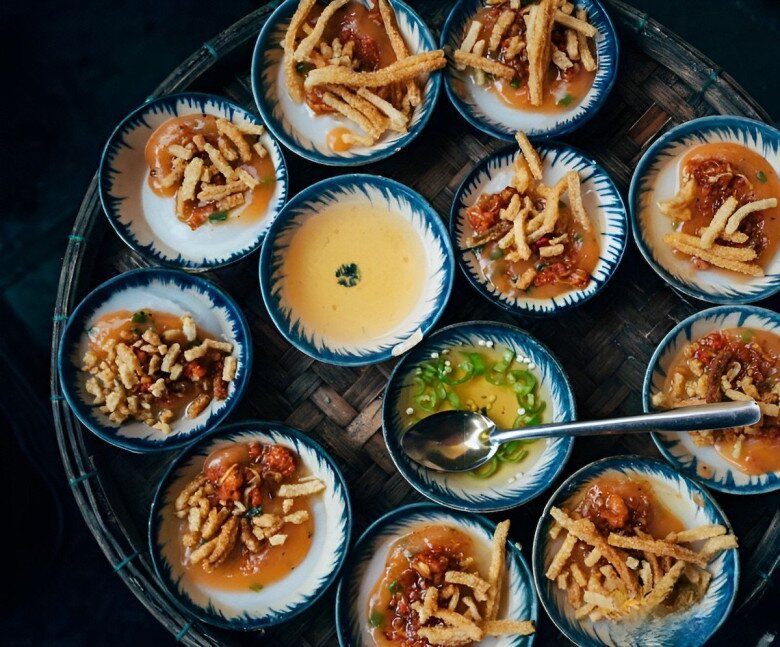
When savored, the dish offers a delightful fusion of flavors: the subtle sweetness of rice flour, the savory shrimp flakes, the richness of fried shallots, and the spicy kick of chili-garlic fish sauce. These flavors melt in the mouth, creating an irresistible taste sensation.
Banh Beo Hue delights not only with its taste but also with its meticulous and laborious preparation. From selecting the right rice, grinding it into flour, to steaming the cakes and preparing the toppings, each step is carefully executed. Thus, every Banh Beo cake embodies the dedication and soul of its maker, contributing to a distinctive dish that embodies the essence of Hue’s cultural heritage.
Che Heo Quay
Che Heo Quay, a unique Hue delicacy, boldly combines the sweetness of che (sweet soup) with the savory taste of roasted pork. Tender rice flour wrappers enclose crispy roasted pork, seasoned with a unique blend of spices. The clear, sweet syrup infused with ginger, combined with the richness of coconut milk, creates an unforgettable flavor symphony.
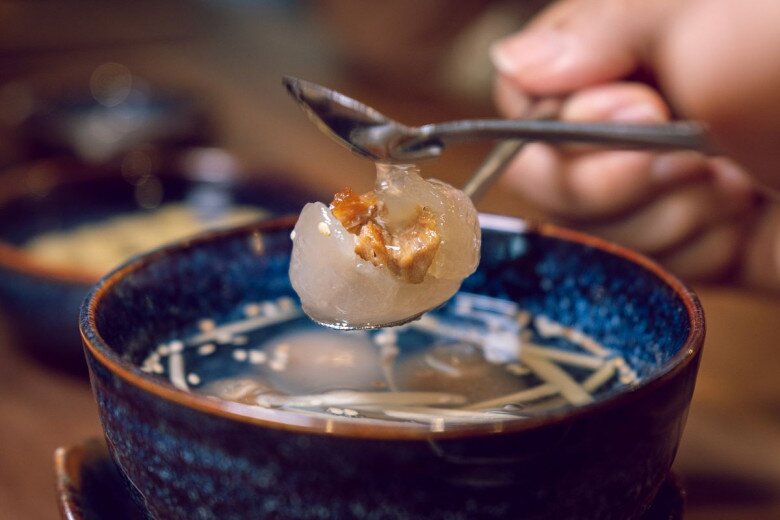
When enjoyed, the dish presents a fascinating contrast between the sweetness of the che and the savory taste of the roasted pork.
The chewy rice flour wrappers, crispy roasted pork, and sweet syrup come together to create a distinctive culinary experience that leaves a lasting impression. Che Heo Quay is more than just a dish; it embodies the creativity and refinement of Hue’s culinary culture.
The Mystical Second-Day-of-Tet Market in Hai Duong: A Unique Tradition Where Haggling is Forbidden.
The annual Dinh Ca Market, held on the second day of Lunar New Year in Hai Duong, is a unique trading and spiritual event. Unlike typical markets, there is no haggling or bargaining here; instead, it is a place of goodwill and auspicious wishes for the coming year. The market holds a special significance for both sellers and buyers, who come together to seek blessings and fortune for a prosperous new year ahead.
The Midnight Harvest: A Delicate Delicacy Illuminated.
After the sun sets, the locals in the western provinces of Vietnam embark on a unique nocturnal endeavor. They gather in groups and venture out into the night to forage for a delicacy known as “mushroom termite.” These prized fungi, sprouting from termite mounds, are sought-after ingredients for upscale restaurants and gourmet chefs. The locals’ nocturnal expeditions are not merely recreational; they are a means to earn a substantial income by supplying this exotic ingredient to discerning chefs and gourmet enthusiasts.



























